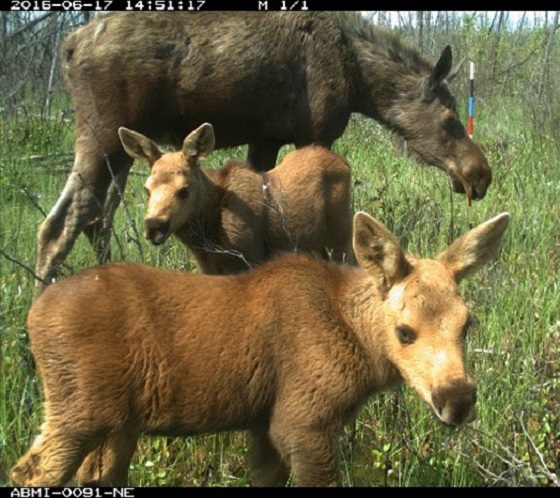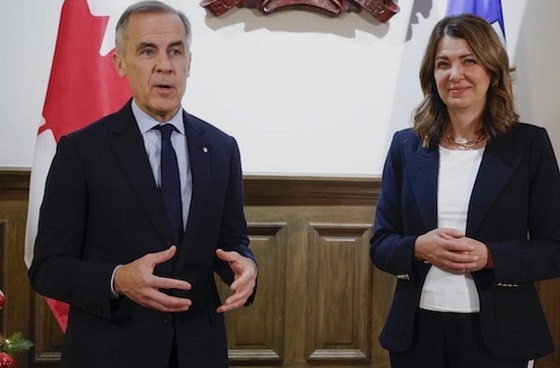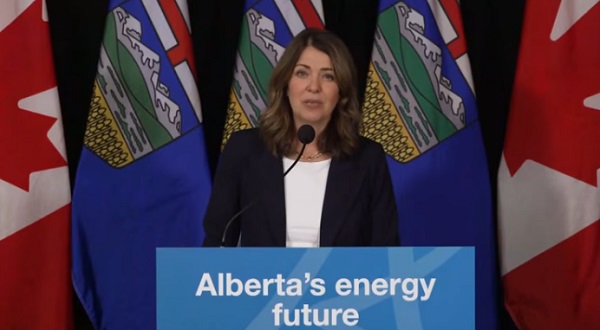Alberta
Alberta wildlife is ready for its close-up

Two moose calves in Wood Buffalo National Park. Photo credit: Alberta Biodiversity Monitoring Institute (ABMI).
Researchers are using remote cameras and cutting-edge tools to better study and monitor Alberta’s wildlife.
Researchers have used remote cameras to monitor wildlife in Alberta for many years, and for good reason: the technology is cost-effective, efficient and safe while enabling researchers to observe multiple species at the same time. However, collecting the data, coordinating with other researchers and reporting information effectively can be challenging.
Alberta’s government is teaming up with researchers to develop new resources and tools that will help wildlife experts work together, study and monitor bears, moose, cougars and other species from miles away.
“We are dedicated to wildlife conservation in Alberta. Led by our Chief Scientist, we are helping researchers better understand how wildlife is behaving and responding to the world around them to help make sure that Alberta’s amazing wildlife continue to grow and thrive for future generations.”
Remote cameras, also referred to as wildlife cameras or camera traps, are important tools for wildlife conservation. Their footage allows researchers to gain a better understanding of wildlife numbers, behaviours and ways to support conservation, all while keeping humans at a safe distance from the action.
The use of remote cameras by Alberta researchers, agencies, industry and the public has been steadily increasing. Alberta’s government and the Alberta Biodiversity Monitoring Institute (ABMI) have helped distribute remote cameras to every corner of the province, from the boreal forest in the north to the grasslands in the south, tracking more than 2,500 species.
Through a $66,000 grant by the Office of the Chief Scientist in 2022, Alberta Environment and Protected Areas, ABMI and the University of Alberta developed new remote camera standards and best practice resources, as well as training materials and tools for wildlife monitoring. As part of this project, Alberta released new remote camera survey guidelines and standards to help improve research, data collection and reporting. This work also improved Alberta’s understanding of what remote cameras are capturing, leading researchers to adjust the cameras and get a clearer picture of wildlife conditions.
This year, another $70,000 in government funding will go towards creating a new online tool to help researchers design remote camera projects, gather data and analyze it. With remote cameras placed throughout the province, this new online tool will help Alberta’s wildlife monitoring projects streamline and coordinate their efforts, regardless of their location, leading to better research.
“The Office of the Chief Scientist is proud to support research and guidance on use of cutting-edge technology to help improve monitoring of provincial wildlife populations. This work will produce results to support the management and conservation of mammals and other wildlife species in the province.”
“Alberta collects a vast amount of data using remote wildlife cameras. The funds provided by the chief scientist’s office will help us develop analysis frameworks that make the work done by individual organizations more consistent, repeatable and transparent. It also will help us better approaches for sharing data that drastically improve our ability to measure and manage at broad scales the species and ecosystems that we treasure.”
“The implications for data compatibility are huge: the more the standards are adopted by remote camera users, the larger the pool of data available to answer bigger and broader questions about wildlife. The Alberta remote camera steering committee is now working to develop accessible tools to support all users, from new to experienced users, in designing remote camera projects, data analysis and modelling. This will help more people conduct effective wildlife camera research and monitoring while also increasing the amount of data available to all.”
Quick facts
- The Office of the Chief Scientist coordinates the delivery of an environmental science program to provide scientifically rigorous data, information and reporting on the condition of Alberta’s environment.
- Grants through the Office of the Chief Scientist support evidence-informed decisions on programs and policies addressing Alberta’s natural resources.
- Remote cameras are most often used to monitor medium to larger mammals like white-tailed deer and bears but can also capture images of smaller creatures like birds and amphibians. They are also used to monitor elusive and far-ranging predators like wolverines and cougars.
- Typically, the camouflaged camera is mounted to a tree or post. Some are programmed to trigger when movement or a change in heat is detected in their field of view, while others are activated by a timer. The camera collects data on all species that pass by and stamps the video or picture with the date and time.
- The chief scientist and the Alberta government are committed to supporting research and delivering accessible reporting on the condition of Alberta’s environment.
Related information
- Remote Camera Survey Guidelines and Alberta Metadata Standards
- Wildlife Cameras for Adaptive Management
Multimedia
Alberta
IEA peak-oil reversal gives Alberta long-term leverage

This article supplied by Troy Media.
The peak-oil narrative has collapsed, and the IEA’s U-turn marks a major strategic win for Alberta
After years of confidently predicting that global oil demand was on the verge of collapsing, the International Energy Agency (IEA) has now reversed course—a stunning retreat that shatters the peak-oil narrative and rewrites the outlook for oil-producing regions such as Alberta.
For years, analysts warned that an oil glut was coming. Suddenly, the tide has turned. The Paris-based IEA, the world’s most influential energy forecasting body, is stepping back from its long-held view that peak oil demand is just around the corner.
The IEA reversal is a strategic boost for Alberta and a political complication for Ottawa, which now has to reconcile its climate commitments with a global outlook that no longer supports a rapid decline in fossil fuel use or the doomsday narrative Ottawa has relied on to advance its climate agenda.
Alberta’s economy remains tied to long-term global demand for reliable, conventional energy. The province produces roughly 80 per cent of Canada’s oil and depends on resource revenues to fund a significant share of its provincial budget. The sector also plays a central role in the national economy, supporting hundreds of thousands of jobs and contributing close to 10 per cent of Canada’s GDP when related industries are included.
That reality stands in sharp contrast to Ottawa. Prime Minister Mark Carney has long championed net-zero timelines, ESG frameworks and tighter climate policy, and has repeatedly signalled that expanding long-term oil production is not part of his economic vision. The new IEA outlook bolsters Alberta’s position far more than it aligns with his government’s preferred direction.
Globally, the shift is even clearer. The IEA’s latest World Energy Outlook, released on Nov. 12, makes the reversal unmistakable. Under existing policies and regulations, global demand for oil and natural gas will continue to rise well past this decade and could keep climbing until 2050. Demand reaches 105 million barrels per day in 2035 and 113 million barrels per day in 2050, up from 100 million barrels per day last year, a direct contradiction of years of claims that the world was on the cusp of phasing out fossil fuels.
A key factor is the slowing pace of electric vehicle adoption, driven by weakening policy support outside China and Europe. The IEA now expects the share of electric vehicles in global car sales to plateau after 2035. In many countries, subsidies are being reduced, purchase incentives are ending and charging-infrastructure goals are slipping. Without coercive policy intervention, electric vehicle adoption will not accelerate fast enough to meaningfully cut oil demand.
The IEA’s own outlook now shows it wasn’t merely off in its forecasts; it repeatedly projected that oil demand was in rapid decline, despite evidence to the contrary. Just last year, IEA executive director Fatih Birol told the Financial Times that we were witnessing “the beginning of the end of the fossil fuel era.” The new outlook directly contradicts that claim.
The political landscape also matters. U.S. President Donald Trump’s return to the White House shifted global expectations. The United States withdrew from the Paris Agreement, reversed Biden-era climate measures and embraced an expansion of domestic oil and gas production. As the world’s largest economy and the IEA’s largest contributor, the U.S. carries significant weight, and other countries, including Canada and the United Kingdom, have taken steps to shore up energy security by keeping existing fossil-fuel capacity online while navigating their longer-term transition plans.
The IEA also warns that the world is likely to miss its goal of limiting temperature increases to 1.5 °C over pre-industrial levels. During the Biden years, the IAE maintained that reaching net-zero by mid-century required ending investment in new oil, gas and coal projects. That stance has now faded. Its updated position concedes that demand will not fall quickly enough to meet those targets.
Investment banks are also adjusting. A Bloomberg report citing Goldman Sachs analysts projects global oil demand could rise to 113 million barrels per day by 2040, compared with 103.5 million barrels per day in 2024, Irina Slav wrote for Oilprice.com. Goldman cites slow progress on net-zero policies, infrastructure challenges for wind and solar and weaker electric vehicle adoption.
“We do not assume major breakthroughs in low-carbon technology,” Sachs’ analysts wrote. “Even for peaking road oil demand, we expect a long plateau after 2030.” That implies a stable, not shrinking, market for oil.
OPEC, long insisting that peak demand is nowhere in sight, feels vindicated. “We hope … we have passed the peak in the misguided notion of ‘peak oil’,” the organization said last Wednesday after the outlook’s release.
Oil is set to remain at the centre of global energy demand for years to come, and for Alberta, Canada’s energy capital, the IEA’s course correction offers renewed certainty in a world that had been prematurely writing off its future.
Toronto-based Rashid Husain Syed is a highly regarded analyst specializing in energy and politics, particularly in the Middle East. In addition to his contributions to local and international newspapers, Rashid frequently lends his expertise as a speaker at global conferences. Organizations such as the Department of Energy in Washington and the International Energy Agency in Paris have sought his insights on global energy matters.
Troy Media empowers Canadian community news outlets by providing independent, insightful analysis and commentary. Our mission is to support local media in helping Canadians stay informed and engaged by delivering reliable content that strengthens community connections and deepens understanding across the country.
Alberta
READ IT HERE – Canada-Alberta Memorandum of Understanding – From the Prime Minister’s Office

-

 Alberta10 hours ago
Alberta10 hours agoFrom Underdog to Top Broodmare
-

 armed forces2 days ago
armed forces2 days ago2025 Federal Budget: Veterans Are Bleeding for This Budget
-

 Alberta1 day ago
Alberta1 day agoAlberta and Ottawa ink landmark energy agreement
-

 Artificial Intelligence2 days ago
Artificial Intelligence2 days agoTrump’s New AI Focused ‘Manhattan Project’ Adds Pressure To Grid
-

 International2 days ago
International2 days agoAfghan Ex–CIA Partner Accused in D.C. National Guard Ambush
-

 Carbon Tax1 day ago
Carbon Tax1 day agoCanadian energy policies undermine a century of North American integration
-

 International1 day ago
International1 day agoIdentities of wounded Guardsmen, each newly sworn in
-

 International2 days ago
International2 days agoTrump Admin Pulls Plug On Afghan Immigration Following National Guard Shooting






